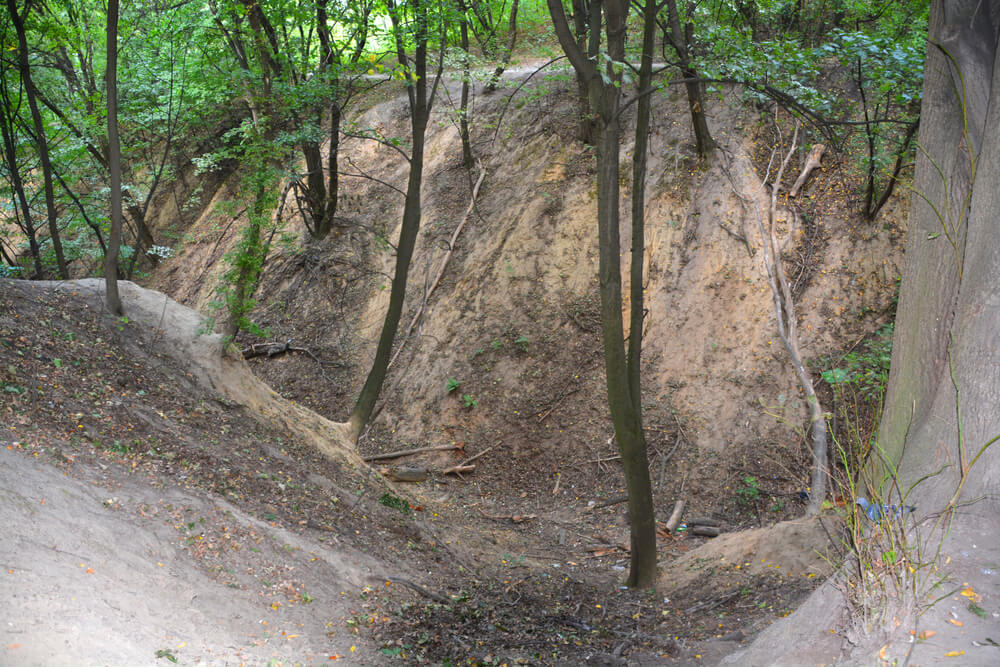Anniversary of Babyn Yar tragedy: chronicle of terrible events and memories of survivors
In two days in September 1941, more than 30 thousand Jews were shot on the outskirts of Kiev. It was one of the largest mass actions of the destruction of civilians during the Second World War, recalls DW.

Photo: Shutterstock
In two days, on September 29 and 30, 1941, 33 people were shot on the outskirts of Kiev. Among them were Jews, Sinti and Roma, Soviet prisoners of war, underground communists. But there were the majority of Jews: more than 771 thousand people. The shootings in the Babiy Yar tract became one of the largest mass extermination actions during the Second World War.
In pre-war Kiev there were 224 Jews, that is, 000% of the city's population. More than three-quarters of Kiev's Jews managed to leave it before the Germans entered it on September 26,5, 19. The city, realizing the inevitability of the German offensive, began to prepare for the evacuation, says "New Time".
“Kiev in attacks of fever, bordering on panic, turned into a place of complete confusion. There is vanity everywhere, as if in a hive. In institutions and enterprises, documents are hurriedly burning, ”wrote Oleksandr Skotsen, a Lviv footballer who moved to Kiev after the Soviet Union annexed Western Ukraine.
On September 19, the Ukrainian capital, which lasted 72 days, fell. Having occupied the city, the Nazis immediately began persecuting the Jewish population of Kiev. A premonition of tragedy was in the air - behind the Germans, who had previously captured Zhitomir and other Ukrainian cities, a long trail of Jewish blood was drawn.
By this time, the executions took place in Shepetovka, Berdichev, Vinnitsa, Kamenets-Podolsk - in the summer of 1941, the Nazis killed 95 thousand Jews.
A week after the seizure of the Ukrainian capital, an order from the German command was posted on its streets: all Jews living in Kiev should gather at eight in the morning on September 29 at the corner of Melnik and Dokterivska streets, taking with them “documents, money and valuables, as well as warm clothes , linen, etc. ". The Nazis threatened to shoot those who did not follow their orders.
At the same time, the SS units arrested nine Kiev rabbis, forcing them to issue a statement that "after sanitation, the Jews and their children will be transported to safe places."
Among the part of the Jewish population of Kiev, there was still the hope that they would not face a terrible outcome, and only deportation from what lay ahead. As the Kiev guide Elina Bondarenko notes, there were several reasons for this:
1. Many people in Kiev still remembered the Germans of 1918, who then occupied Kiev and behaved here more than decently.
2. Not far from Babi Yar there was a railway station. And the German order said that you need to take the necessary things with you.
3. No one else has ever resorted to the practice of mass executions of civilians.
As the Kiev Jew Dina Pronicheva, who managed to escape from Babi Yar, writes in her memoirs, on September 29 the Jews went to the place of execution "in hundreds, thousands."
“We lived in fear and horror. When I saw posters on the streets of the city and read the order: "All the Jews of Kiev to gather at Babi Yar", which we had no idea about, I felt trouble in my heart ... Therefore, I dressed my kids, the youngest is 3 years old, and the oldest is 5 years old, I packed their things in a small bag and took her daughter and son to my Russian mother-in-law. Then she took her sick mother and together with her, according to the order, went out on the road that leads to Babi Yar.
Jews marched in hundreds, thousands. An old Jew with a long beard walked beside me. He was wearing a talis and tefillin. He muttered softly. He prayed just like my father did when I was still a child. In front of me was a woman with two children in her arms, the third one clung to her skirt, ”Pronicheva describes that day.

Photo: Shutterstock
Babi Yar was chosen by the German command due to the presence of ditches and ravines there. This made the task easier for the executioners: they did not have to dig deep graves for thousands of corpses. In addition, the place was far enough from the city center: it was easy to hide from the curious, and no shots were heard.
This was not just an execution. It was a conveyor belt. People screaming in horror were shot in the back of the head for several hours on end. On the first day alone, more than 20 thousand people were shot. One group of Germans was directly responsible for the execution, the other laid out the corpses, the third sorted valuables, the fourth guarded those who were waiting for their “turn”...
Execution
Shortly before the fateful day, Sonderkommando 4A of Einsatzgroup C, a death squad that destroyed the civilian population in the territories captured by the Wehrmacht, arrived in occupied Kiev.
Berlin historian Wolfgang Benz noted that, accompanying the regular units of the army of the Third Reich, the Einsatzgruppen "cleaned out unwanted elements" in the occupied lands. At the same time, according to the American historian Timothy Snyder, not only the SS and representatives of the SD (Nazi special services, but also ordinary policemen, civilians, as well as officers and soldiers of the Wehrmacht) participated in organizing the shootings.
On the morning of September 29, 1941, thousands of Jews gathered at the corner of Kiev's Melnik and Dokterivskaya streets (the Nazis themselves wrote about 20 thousand), who were led in the direction of Babi Yar - first without armed escort, later - at gunpoint from SS men.
Men, women and children were led along Dorogozhitskaya Street, which ran along the Lukyanovskoye cemetery, near which they were ordered to stop and hand over their valuables and jewelry. A corridor was formed from SS men with dogs and local policemen, along which people were driven, beating them along the way. The Jews were allowed into the territory of Babi Yar in groups, according to various estimates, from 40 to 600 people.
“I passed and realized that there, behind the barbed wire, behind the Jewish cemetery, you can't run anywhere. There were a lot of Jews there. By the way, I arrived late at night, and we were not undressed, I was in clothes. Before that, an hour, two hours before they undressed everyone. (…) Twenty dogs, shepherd dogs, were launched, these shepherds began to bite people by the legs, and people ran forward, ”wrote the Kiev Jew David Aizenberg about that day.
Passing through the SS corridors, people found themselves on a wide area, separated from the ravine, which was called Babi Yar. Because of the embankment, the victims did not see the ravine itself. The Jews were ordered to undress and forced to run through narrow passages in a tight stream - it was impossible to stop.
At the end of the path, the man found himself on a ledge made on the slope of a ravine, on the opposite side of which there were machine gunners from the Sonderkommando 4A of Einsatzgroup C, who opened fire.
“The policeman ordered me to undress and pushed me to the cliff ... But even before the shots rang out, I, apparently, from fright, fell down into the hole ... The first minutes I could not make out anything: where I was, how I got here ... I I began to feel my arms, legs, stomach, head and made sure that I was not even wounded ... I hid as if I was dead ... And the shooting continued ...
Suddenly everything became quiet. It began to get dark... I felt that we were being covered with earth... When it got completely dark and there was silence, in the full sense - dead silence, I opened my eyes and, making sure that there was no one around, no one could see me, I threw off the sand,” she wrote Dina Pronicheva, who survived the tragedy of those days.
On the subject: 'Unknown Holocaust': Russian-speaking director made a series of films about the genocide of Jews in the USSR
Executioners: Sonderkommando 4A of Einsatzgroup C
According to Berlin historian Wolfgang Benz, the Einsatzgruppen were originally created as death squads. Accompanying the Wehrmacht, these units “cleaned out undesirable elements” in the occupied territories. According to the American historian Timothy Snyder, it is also important to realize that not only representatives of the SD security service and SS men, but also ordinary German police officers, as well as representatives of civilian departments, officers and soldiers of the Wehrmacht participated in the organization and conduct of the mass execution.
A separate trial was devoted to the investigation of the activities of the Einsatzgruppen within the framework of the so-called subsequent, or small Nuremberg trials. Some unit leaders were convicted as war criminals. Kurt Werner, who appeared in court in Nuremberg, talking about the executions of 1941, “complained” about “the nerves it cost” them, German officers, to do such “dirty work.”
“In order, so to speak, to save the nerves of the executioners, the Nazis searched for simpler and more effective methods of mass extermination of people, which is why experiments with asphyxiating gases were carried out in Auschwitz,” says historian Wolfgang Benz.

Photo: Shutterstock
The Holocaust is more than just gas chambers
As historian Timothy Snyder notes, Babi Yar became for the leadership of the “Third Reich” a kind of demonstration of what the Germans were in principle capable of: they were capable of virtually completely destroying the Jewish population of a large European city in two days.
“The mass murder of Jews did not begin in the gas chambers of Auschwitz. Already at the time of the Wannsee Conference in 1942, where the ways of the “final solution of the Jewish question” were discussed, at least half a million Jews had been shot,” says Wolfgang Benz.
On the subject: 'It takes time to resurrect a person in itself': how the last Holocaust witnesses survived and live
Continuation of crimes
Nazi atrocities at Babi Yar continued until the retreat of German troops from Kyiv in November 1943. During the occupation of the Ukrainian capital, the Nazis destroyed five Roma camps in the tract; 621 members of the Organization of Ukrainian Nationalists were shot, including the poetess Elena Teliga, her husband Mikhail and the editor of the newspaper “Ukrainian Word” Ivan Rogach; representatives of the Karaite ethnic group, hostages, underground fighters, partisans and prisoners of the Syretsky concentration camp.
In total, according to one estimate, 200 thousand people became victims of Babi Yar, a third of them were Jews.
In July 1943, shortly before retreating from the city, the Nazis began to destroy evidence of the massacres at Babi Yar - the so-called "Operation 1005" was launched, in charge of which was Paul Blobel, the commander of Sonderkommando 4A of Einsatzgroup C.
“In November 1942, in Berlin, Blobel gave a lecture to a group of Eichmann specialists on the Jewish question in the occupied territories. He talked about special cremation ovens that he personally designed for use in the work of Team 1005. His task was to open graves, remove from them and incinerate the bodies of previously executed persons. Team 1005 operated in Russia, Poland and the Baltics. Then I saw Blobel in Hungary in 1944 and he confirmed to Eichmann in my presence that the mission of Team 1005 had been accomplished, ”said one of the SS officers during the Nuremberg trials.
The Nazi concealment of their crimes seriously hindered the identification of victims of the atrocities at Babi Yar. Currently, the eponymous Holocaust memorial center is trying to restore all those killed at the hands of the executioners of Kiev by name - now there are over 18 thousand names on the list.
After the war, the executioner of Babi Yar Paul Blobel appeared before the Nuremberg Tribunal and was hanged on June 7, 1951. Other participants in the crime - the military commandant of Kiev, Major General Kurt Eberhard and the civil governor (general commissioner) of the city Helmut Kwitzrau - escaped punishment by dying a natural death in post-war Germany.
Babi Yar, along with the Auschwitz concentration camp, remains one of the main and horrific symbols of the Holocaust.
Read also on ForumDaily:
'Madonna of War': how a brave nun saved dozens of Jewish children from the Nazis
What is the real Brighton Beach like: a dream area within a huge metropolis
13 pluses of living in the USA according to a Russian-speaking immigrant
Subscribe to ForumDaily on Google NewsDo you want more important and interesting news about life in the USA and immigration to America? — support us donate! Also subscribe to our page Facebook. Select the “Priority in display” option and read us first. Also, don't forget to subscribe to our РєР ° РЅР ° Р »РІ Telegram and Instagram- there is a lot of interesting things there. And join thousands of readers ForumDaily New York — there you will find a lot of interesting and positive information about life in the metropolis.











